Separated entry and exit doors for calcium keep energy production smooth in the powerhouses of heart cells

Stress demands the heart to work harder and faster. To keep pace, the muscle must make its fuel at an accelerated rate. Bursts of calcium entering mitochondria—the cell's powerhouses—normally help control energy output, but too much calcium can overload the system and lead to cell death. Now research led by Jefferson (Philadelphia University + Thomas Jefferson University) scientist Gyorgy Csordas shows how mitochondria manage the flow of calcium to keep the engine running smoothly.
"What really matters is if there is a stress," said Dr. Csordas, MD, an Associate Professor at the MitoCare Center within the department of Pathology, Anatomy and Cell Biology at the Sidney Kimmel Medical College at Jefferson. "Your heart is going to work harder, so it takes more energy."
When it comes to calcium, mitochondria are a bit like Goldilocks—too much calcium triggers a series of events that result in cellular suicide, but too little impairs the ability of the conveyor belt of reactions that pump out ATP, the cell's fuel. Since the heart muscle needs ATP to contract, mitochondria must constantly replenish the heart's energy stores. That means mitochondria need just the right amount of calcium to keep the energy factory humming along.
A rush of calcium to mitochondria also helps the heart tolerate stress. An accelerated heart rate triggers more calcium to flood the mitochondria. The mitochondria in turn produce more ATP to allow the heart to respond to the stress.
"We wanted to figure out how this finely tuned system operates," said Dr. Csordas, who published the work on September 18, 2018 in the journal Cell Reports with first author Sergio De La Feuente, Ph.D., a postdoctoral fellow in Csordas' lab.
To manage how much calcium enters its chambers, mitochondria have one-way doors called mitochondrial calcium uniporter channel complexes (MCUCs) that control access. To keep from overloading mitochondria with calcium, the doors remain sealed most of the time; they only open when enough calcium is nearby to unlock them,but calcium needs a door by which to exit as well to keep levels safe.
In previous research, Csordas' team found the MCUCs cluster together in hotspots on mitochondria, strategically positioned near where the heart's dedicated calcium store, called the sarcoplasmic reticulum (SR), touches the mitochondria. It was less clear, however, where the calcium exit doors were located.
Researchers knew that calcium exits mitochondria by way of a revolving door, a transport protein called NCLX. To find out where the calcium exit doors are on mitochondria, researchers broke up heart cells from male mice and rats and probed for different parts of the cell. They found MCUC entry doors alongside the SR calcium store, as they expected, but exit door proteins were almost entirely absent. Instead, the team found the exit doors were abundant only in areas with little to no SR contact, far from the entrances.
The discovery made sense to Dr. Csordas. "If calcium entrance and exits were too close together, some of the calcium could come in and go out without doing anything," he said. That would still cost the mitochondrion energy since calcium entry and exit through these doors both require a basic energy investment from the mitochondrion. "Such an outcome would leave the cell without the appropriate demand signal to make energy," he said.
Indeed, the researchers found that inserting exit doors close to MCUC entrances cost the mitochondria more energy.
Together the position of the calcium entrances and exits allow mitochondria to operate at maximum efficiency even when stressed.
"This is the first or one of the first examples showing the driving effect of the inter-organelle contact on the distribution of mitochondrial transporters," Dr. Csordas said.
More information: Sergio De La Fuente et al, Spatial Separation of Mitochondrial Calcium Uptake and Extrusion for Energy-Efficient Mitochondrial Calcium Signaling in the Heart, Cell Reports (2018). DOI: 10.1016/j.celrep.2018.08.040

















